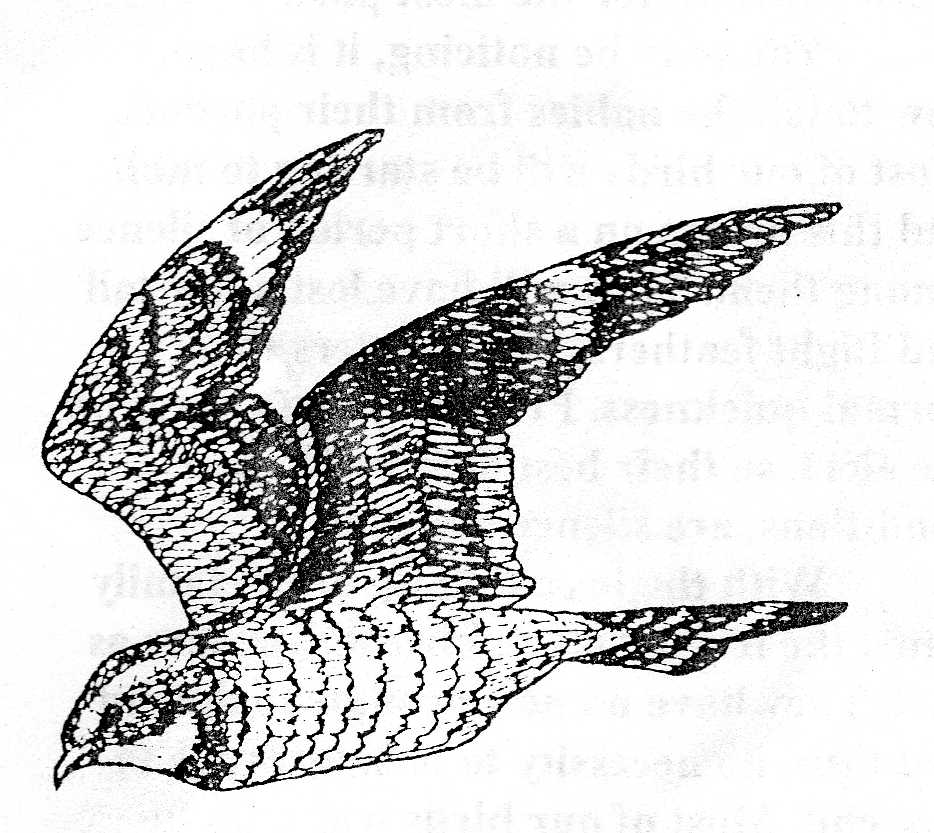Common Birds
Common Nighthawk
The Common Nighthawk, a Nightjar, is perhaps the most easily seen and recognized of the various species that comprise the goatsucker family of birds. Nightjars are medium-sized nocturnal birds with long wings, short legs and very short bills that usually nest on the ground. Nightjars are sometimes referred to as goatsuckers from the mistaken belief that they suck milk from goats. Its close relatives are the Poor-will and the Whip-poor-will. This bird is often seen in groups lazily flying, swooping and darting through the sky picking off many varieties of large and small insects. Its wide gaping mouth sweeps them in with ease. The variety ranges from grasshoppers and beetles to flies and mosquitoes.
medium-sized nocturnal birds with long wings, short legs and very short bills that usually nest on the ground. Nightjars are sometimes referred to as goatsuckers from the mistaken belief that they suck milk from goats. Its close relatives are the Poor-will and the Whip-poor-will. This bird is often seen in groups lazily flying, swooping and darting through the sky picking off many varieties of large and small insects. Its wide gaping mouth sweeps them in with ease. The variety ranges from grasshoppers and beetles to flies and mosquitoes.
The silhouette of this bird resembles that of a small hawk and thus its name. The adults have dark with brown, grey and white patterning on the upperparts and breast; the long wings are black and reveal a white bar when in flight. The tail is dark with white barring; the under parts are white with black bars. The adult male has a white throat; the female has a light brown throat. Its flight is very moth like to me as they glide and dart through the sky.
When migrating during the spring and fall, they may travel in small to huge flocks. Occasionally they are high in the sky picking off their food and at other times they may be brushing close to the ground in your backyard. As they fly along they utter loud “peet” or nasal “veer” sounds, which must bounce off and help them locate their insect prey.
Nighthawks winter in South America . Their spring arrival date in our area is normally the month of May. Their breeding habitat is open country across North America . They usually nest on bare ground where the nest consists of nothing more than a depression in the gravel or dirt. Sometimes these birds may nest in raised locations including on stumps. A favorite location has become flat roofs of various buildings with rock as a cover over tar. Although these roofs provide a safe place from predators and humans, they become extremely hot in full summer sun and may impact the successful hatching of eggs. At 107°, most eggs die. Some roof temperatures however have reached 120° and above. These birds have an ingenious way of controlling the heat of the eggs on the nest. If it gets too hot on the roof or other areas of choice, the bird hovers over the nest, fanning the eggs with their wings. These birds especially favor burned areas in forests.
The female Nighthawk lays two creamy buff colored eggs mottled with brown. They are laid directly on bare ground. Incubation is performed largely by the female and lasts for about 20 days. During incubation the male feeds her on the nest, and then assists with the rearing of the young. These young Nighthawk nestlings fledge at about 20 days of age. There is usually just one nesting each year except in southern states where they may have a second brood.
The feeding time for these birds can range from daylight to night time. They catch flying insects on the wing, mainly foraging near dawn and dusk. Sometimes Nighthawks can be seen feeding during the night with a full moon or near street lighting. Watch for them around creek and river bridges that are lit, or business districts where the lights attract moths and other flying insects. It is fun on a summer night to just watch these aerial acrobats perform their maneuvers.
Contributed by Mr. Weir Nelson of Wildlife Habitat, Cedar Rapids, Iowa
